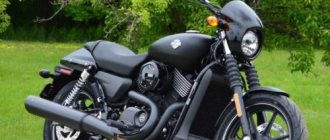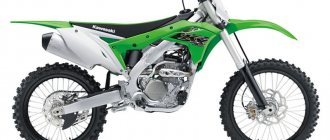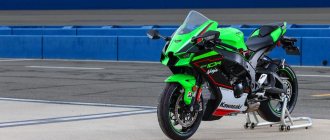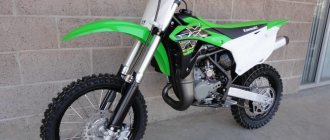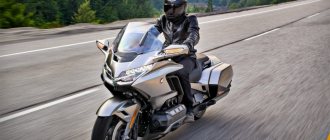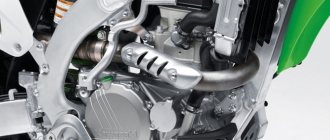| Kawasaki KX125 (KX125A) 1974-1981 | Kawasaki KX125 (KX125B) 1982-1983 | Kawasaki KX125 (KX125C) 1984 |
| Kawasaki KX125 (KX125D) 1985 | Kawasaki KX125 (KX125E) 1986-1987 | Kawasaki KX125 (KX125F) 1988 |
| Kawasaki KX125 (KX125G) 1989 | Kawasaki KX125 (KX125H) 1990-1991 | Kawasaki KX125 (KX125J) 1992-1993 |
| Kawasaki KX125 (KX125K) 1994-1998 | Kawasaki KX125 (KX125L) 1999-2002 | Kawasaki KX125 (KX125M) 2003-2008 |
the Kawasaki KX 125 motocross motorcycle
was first introduced in 1974 and for many years was only available in the North American market. Since 1988, the model has appeared on the markets of Europe and Japan, and since 1990 - in Australia.
The model is the “younger brother” of the Kawasaki KX 250 and has much in common with it - in particular, the frame and chassis. Even updates to both models took place in the same years.
Despite the long history of production of the Kawasaki KX125 and a huge number of generations, we should consider models starting from 1990 - that’s when the motorcycle received an inverted fork and features of modern motocross models. In addition, earlier versions are practically not represented on the market.
Features of the Kawasaki KX125 include a 2-stroke liquid-cooled engine with a power valve system (KIPS), a steel half-duplex frame, adjustable sports suspension, disc brakes, 21′ and 19′ wheels, an 8.5-liter fuel tank, 6-speed Gearbox and 87 kg dry weight.
2008 was the last year of production of the model, after which it finally left the market and received no further development. Instead, a 4-stroke modification of the Kawasaki KX250F was presented.
Main competitors of Kawasaki KX 125:
- Honda CR 125R
- Suzuki RM 125
- Yamaha YZ 125
Dimensions and weight
The weight of the bike without fuel is 87 kg. Compared to motorcycles of many other classes, this is a very small figure. The gas tank capacity reaches only 8.2 liters, but this is natural for this class, because otherwise such a weight would not be possible. The length of the model is 2165 mm, its height is 1265 mm, and its width is 815 mm. The saddle height reaches 945 mm. The wheelbase dimensions of the motorcycle are 1470 mm.
Brief history of the model
- 1974 - start of production and sales. First generation
.
Model
: Kawasaki KX125 (North America).
Factory designation:
KX125-A1.
- 1975 - no significant changes.
Model
: Kawasaki KX125 (North America).
Factory designation:
KX125-A2.
- 1976 - no significant changes.
Model
: Kawasaki KX125 (North America).
Factory designation:
KX125-A3.
- 1978 - no significant changes.
Model
: Kawasaki KX125 (North America).
Factory designation:
KX125-A4.
- 1979 - no significant changes.
Model
: Kawasaki KX125 (North America).
Factory designation:
KX125-A5.
- 1980 - no significant changes.
Model
: Kawasaki KX125 (North America).
Factory designation:
KX125-A6.
- 1981 - no significant changes.
Model
: Kawasaki KX125 (North America).
Factory designation:
KX125-A7.
- 1982 - restyling of the model. Second generation
.
Model
: Kawasaki KX125 (North America).
Factory designation:
KX125-B1.
- 1983 - no significant changes.
Model
: Kawasaki KX125 (North America).
Factory designation:
KX125-B2.
- 1984 - restyling of the model. Third generation
.
Model
: Kawasaki KX125 (North America).
Factory designation:
KX125-C1.
- 1985 - restyling of the model. Fourth generation
.
Model
: Kawasaki KX125 (North America).
Factory designation:
KX125-D1.
- 1986 - restyling of the model. Fifth generation
.
Model
: Kawasaki KX125 (North America).
Factory designation:
KX125-E1.
- 1987 - no significant changes.
Model
: Kawasaki KX125 (North America).
Factory designation:
KX125-E2.
- 1988 - restyling of the model. Sixth generation
.
Model
: Kawasaki KX125 (North America, Europe, Japan).
Factory designation:
KX125-F1.
- 1989 - restyling of the model. Seventh generation
.
Model
: Kawasaki KX125 (North America, Europe, Japan).
Factory designation:
KX125-G1.
- 1990 - restyling of the model. Eighth generation
.
Model
: Kawasaki KX125 (North America, Europe, Japan, Australia).
Factory designation:
KX125-H1.
- 1991 - no significant changes.
Model
: Kawasaki KX125 (North America, Europe, Japan, Australia).
Factory designation:
KX125-H2.
- 1992 - restyling of the model. Ninth generation
.
Model
: Kawasaki KX125 (North America, Europe, Japan, Australia).
Factory designation:
KX125-J1.
- 1993 - no significant changes.
Model
: Kawasaki KX125 (North America, Europe, Japan, Australia).
Factory designation:
KX125-J2.
- 1994 - restyling of the model. Tenth generation
.
Model
: Kawasaki KX125 (North America, Europe, Japan, Australia).
Factory designation:
KX125-K1.
- 1995 - no significant changes.
Model
: Kawasaki KX125 (North America, Europe, Japan, Australia).
Factory designation:
KX125-K2.
- 1996 - no significant changes.
Model
: Kawasaki KX125 (North America, Europe, Japan, Australia).
Factory designation:
KX125-K3.
- 1997 - no significant changes.
Model
: Kawasaki KX125 (North America, Europe, Japan, Australia).
Factory designation:
KX125-K4.
- 1998 - no significant changes.
Model
: Kawasaki KX125 (North America, Europe, Japan, Australia).
Factory designation:
KX125-K5.
- 1999 - restyling of the model. Eleventh generation
.
Model
: Kawasaki KX125 (North America, Europe, Japan, Australia).
Factory designation:
KX125-L1.
- 2000 - no significant changes.
Model
: Kawasaki KX125 (North America, Europe, Japan, Australia).
Factory designation:
KX125-L2.
- 2001 - no significant changes.
Model
: Kawasaki KX125 (North America, Europe, Japan, Australia).
Factory designation:
KX125-L3.
- 2002 - no significant changes.
Model
: Kawasaki KX125 (North America, Europe, Japan, Australia).
Factory designation:
KX125-L4.
- 2003 - restyling of the model. Twelfth generation
.
Model
: Kawasaki KX125 (North America, Europe, Japan, Australia).
Factory designation:
KX125-M1.
- 2004 - no significant changes.
Model
: Kawasaki KX125 (North America, Europe, Japan, Australia).
Factory designation:
KX125-M2.
- 2005 - no significant changes.
Model
: Kawasaki KX125 (North America, Europe, Japan, Australia).
Factory designation:
KX125-M3.
- 2006 - no significant changes.
Model
: Kawasaki KX125 (North America, Europe, Japan, Australia).
Factory designation:
KX125-M6F.
- 2007 - no significant changes.
Model
: Kawasaki KX125 (North America, Europe, Japan, Australia).
Factory designation:
KX125-M7F.
- 2008 is the last year of production.
Model
: Kawasaki KX125 (Europe, Japan, Australia).
Factory designation:
KX125-M8F.
Chassis and brakes
The frame of the KX 125 is perimeter, steel. It is typical for motocross bikes. The wheels are spoked, which allows the motorcycle to have less weight. The steering wheel is of standard sizes for the class and provides good control both during normal and high-speed driving.
The rear suspension is a progressive monoshock absorber with a travel of 310 mm. The front suspension is an inverted fork with dimensions of 48 mm, the travel of which is 300 mm. The rear brake is a 240 mm disc, assisted by a single-piston caliper. The front brake is a 250 mm disc with a two-piston caliper.
Reviews
Reviews about Kawasaki KX 125:
So after Irbisa ttr 125 I decided to buy something more serious and, as I thought, more reliable))
I always wanted to try a 2-stroke, so the mot decided to take a motocross bike, we have several tracks nearby. I was choosing between a Kava and a Honda, I turned up a KX, it seems like a good option from 2003, looks well-groomed, a few niceties in the form of tuning collector and handle protection included..) I decided to take it because the price seemed reasonable.
They took it right away and decided to test what was what. I went to the forest, fortunately it was nearby. I’ll say right away that I was simply perplexed by the dynamics, I would never have believed that 125 cubes could “drive” like that.
Kawasaki KX125 – TEST
2008, 124 cm3, 39.5 l. pp., 87 kg, from 130,000 rub.
text: Yuri Solonovich photo: Nikita Kolobanov
in the photo: Yuri Solonovich
“Two-stroke off-road motorcycles for me have always been, as they say, “a thing in itself.” On the one hand, I naturally recognized their honorable status as the progenitors of all motorcycling, but, on the other hand, I was completely unable to fully ride modern two-stroke equipment!
Why, it didn’t work out before, and it doesn’t really work out now. And if at the very least I managed to make friends with a 2-stroke snowmobile, until recently 2T motorcycles were a very, very uncomfortable topic for me. No, of course, I rode this type of equipment a lot (especially the enduro class), but, frankly speaking, I didn’t get full pleasure. That is why I, without any hesitation, joined the ranks of ardent apologists of the 4-stroke faith and for the last several years I have been an active and fanatical participant in this sect. This means that both in personal and test use I have always preferred proven and familiar modern 4T models. But as fate would have it, on the cross-country track I saw her quite by accident - an already middle-aged green “macaque” produced in 2008 (in case anyone suddenly forgot or simply didn’t know: “macaque” is an Old Slavonic slang designation for 2-stroke 125 cc motorcycles). And, having asked the owner of the motorcycle for an express test, I was immensely, somehow even childishly surprised: the Kawasaki KX125 turned out to be very light and controllable, equipped with a quite friendly, albeit with a little “spice”, engine!
Dissecting a macaque It turned out that, despite its age, the “old lady” has a completely functional and advanced filling. The motorcycle has a 1-cylinder 2-stroke engine with a liquid cooling system and a special composite coating on the cylinder walls. The engine produces an impressive maximum power of 39.5 hp. s., achieved at 11,500 rpm. The gearbox is 6-speed. The power plant is also equipped with the proprietary Kawasaki Integrated Powervalve System (KIPS), which is designed to change the height of the exhaust port and which not only significantly improves engine torque, but also makes possible a variable compression ratio: 8.3: 1 at high speeds, 10.9:1 - at low! The power system is equipped with a rather complex and “sophisticated” Mikuni TMX38x carburetor, the use of which, among other things, reduced the engine’s reaction time to the movement of the gas handle.
The chassis is also very modern. In defiance of its cubic-sized colleagues sporting an aluminum frame, the Kawasaki KX125 has a perimeter frame made of high-alloy steel. The KX125 is equipped with an inverted cartridge fork with a diameter of 48 mm, equipped with 16-step hydraulic compression and rebound adjustment. The rear suspension is a lightweight and compact Uni-Trak linkage system with a fully adjustable monoshock. The brakes are, of course, disc: one 250 mm petal disc with a 2-piston caliper on the front wheel and one 240 mm disc with a 1-piston caliper on the rear.
Into the wild But these are just dry numbers of technical characteristics. Which, alas, will not let you understand the reason for that puppyish delight that overwhelmed me after my first test ride on a motorcycle. As you know, 125 cc 2-stroke machines are a kind of training desk for beginner motocross riders, an intermediate link between children's 2-stroke 85 cc machines and adult 4-stroke models. In practice, first of all, this means that all “macaques” are very light. Judge for yourself - 87 kg of dry mass... for 39.5 full-fledged Japanese “horses”! This ratio makes the Kawasaki amazingly fun to ride, allowing the KX125 to be leaned as low as the laws of physics in the universe will allow it to be leaned into, both in rutted corners and in long flat corners. Sometimes you get the feeling that even the centrifugal force and the force of universal gravity act on him a little differently! But simple surprise gives way to shock as soon as the motorcycle is in the air. With the right riding skills, the Kawasaki can surprise in flight not only the adherents of the 4-stroke faith. If you have the courage and skill to correctly “launch” a green device into the air, then you can fly on it far and for quite a long time. And during the flight, even a not very experienced rider will struggle with an irresistible desire to try to perform a pitiful semblance of a “vip” or “scrub”...
But I would like to immediately warn all those who want to purchase such a motorcycle as their first one about several features of its piloting. Firstly, the KX125, like any 2-stroke motorcycle, completely lacks the concept of “engine braking”. That is, where on a 4-stroke machine you simply close the gas, on a 2T machine you will have to learn how to use the front and rear brakes. Do you think it's easy? Don't tell me! From my own experience, I know that an amateur athlete, spoiled by a “four-stroke”, uses brake mechanisms extremely reluctantly, because at low speeds, simply braking with the engine is often enough for him. Secondly, due to the horse-riding nature of the 2-stroke engine, you will have to learn how to use the gearbox! Again you say it’s simple? Not at all! Almost any average owner (remember, we are talking about amateur athletes) of a motocross motorcycle with an engine capacity of, for example, 450 cm3, as a rule, rides in the range from second to third gear. And the KX125 has six of them, and all of them are in great demand! And don’t forget about the vibrations that shake the motorcycle, the caustic exhaust, the need to mix gasoline and oil, and the rather sharp and explosive character, especially at the top.
It took me six long years to mentally grow to two bars. During this time, I managed to ride a huge number of two- and four-wheeled off-road vehicles, break my bones on sports tracks more than once and change several 4-stroke motocross vehicles in my personal garage. And never in all this time have I felt the desire to spend my hard earned money and buy a 2-stroke motorcycle!.. But after a whole day spent on the motocross track with the Kawasaki KX125, such a desire became somewhat obsessive. It was through this meeting that I identified a potentially reasonable selection of off-road motorcycles for personal use. I think even an older 2-stroke Macaque would be a great addition to any new 4T motorcycle in a personal motorcycle fleet. It is thanks to this device that you will be able to improve and hone your off-road riding skills... But you should not buy it at a very mature age as your first motorcycle: you definitely need to grow into the Kawasaki KX125, both mentally and physically. /
Motorcycle KDX125SR: technical specifications, photos, videos
My mustang:
1. All normal posans ride on two strokes. Two bars is cool. That says it all.
2. Undermining. The characteristic of a two-stroke engine is a sharp burst of power and response to the throttle. It’s very convenient and sometimes helps out.
3. Two bars is fun. The lack of low end (thrust) on a two-stroke is not a bug, it’s a feature. In order for it to run, you need to twist it all the time and run around like crazy. The nature of the motorcycle is that it either doesn’t go or wastes money. For example, to drive through a dirty stream, you need to use the accelerator to release a fountain from under the rear wheel. To drive uphill, you need to unscrew the handle with all your money so that the wheel shoots out a fountain of dust and stones.
4. Picking a Winner Two-strokes are the staple mopeds at crazy competitions like the Erzberg Rodeo and Romaniacs.
5. Freestyler's choice Freestylers do wonders on two-strokes, do you want to be like such cool guys?
6. The smell of childhood A real motorcycle should be noisy and stink))) (Electric bikes and econorms in the furnace) In fact, those who tinkered with scooters in childhood will never forget the heady aroma of a two-stroke exhaust
7. Simplicity of design The two-stroke engine has a very simple design. It is easy and cheap to maintain. The motorcycle has a minimum of electrics, you don’t even need a battery. The motorcycle looks like a tractor, iron, powerful, indestructible, simple - what else is needed for enduro.
8. Water hammer I'm not an expert, but they say that a two-stroke engine cannot have water hammer. I drowned the motorcycle myself. I pulled it out of the ford and drove another 500 km with emulsion in the transmission.
9. 200cc versus 250 I haven’t driven a 250 myself, but I’ve been smoking on American forums. People say that 200cc has more uniform characteristics.
10. Availability of spare parts The KDX200 was very popular in America and Japan. There are plenty of used ones on ebay. The stores are full of spare parts and tuning. There are a lot of developments and tips on tuning.
11. From America or Japan On the American market, the moped version is more powerful. The carburetor and the air filter design are more powerful. But in Japan it is easier to find a moped with a separate lubrication system and an upside-down fork.
12. price The price of KDX on the Russian market is much more affordable than other enduros.
Analogs: Honda CRM 250 - very popular on the Russian market, it is believed that the engine is more technologically advanced, in later versions (CRM250AR) it has an electronic exhaust curtain that gives more low-end. Unknown in Pindosia, spare parts and tuning are a bummer.


